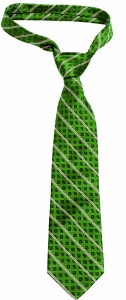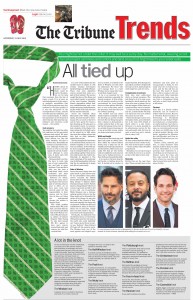You might be hot under the collar. It may well be a sultry day. No matter what, wearing a cool tie can project calmness and control and lend a touch of brightness to your sober suits
Roopinder Singh
“Honey, which tie should I wear?” Much could be read in the plaintive cry for help that emanates from the lips of many a male. It is, at once, an acknowledgement of the superior aesthetic sensibilities that God, in His mysterious ways, has endowed to the fairer gender. It is also the admission of the incompleteness of man…and the need for external validation…but most fundamentally, it reflects the importance of one element of attire that has little practical significance, but enormous social impact — the necktie.
Cool accessory
 You might be hot under the collar, but wearing a cool tie can project calmness and control. Yet, most men struggle with the necktie. Some women, too, face the same situation, but that is another story. Essentially the necktie is a masculine accessory (although women are known to wear it, too) that signals the arrival of adulthood, although in some cases, it starts early with school uniforms.
You might be hot under the collar, but wearing a cool tie can project calmness and control. Yet, most men struggle with the necktie. Some women, too, face the same situation, but that is another story. Essentially the necktie is a masculine accessory (although women are known to wear it, too) that signals the arrival of adulthood, although in some cases, it starts early with school uniforms.
Being an adult is not fun. You have to work, take care of your responsibilities, and take so many decisions. If you are Steve Jobs, you can wear a trade-mark black mock turtleneck and jeans everywhere, all the time.
However, for others, among the many morning rituals is the onerous task of selecting what to wear to office. As we have seen, most men cleverly palm off this responsibility to their spouse, and for those who do have yet taken the matrimonial plunge, the mother is always there!
Who called neckties western attire? We, in the East, can claim that our use of scarves pre-dated that of the West by centuries. Why, the terracotta soldiers of Chinese Emperor Shih Huang Ti, who died around 209 B.C., appear to have worn scarves around their neck, and scarves are what ties evolved from.
It is now well-accepted that the necktie traces its origins to 17th century Croatian mercenaries hired by King Louis XIII of France. These men wore distinctive scarves around their necks as a part of their uniform. The scarves caught the fancy of the King, and were called ‘cravats’, a corruption of the word Croatian. Naturally, French sartorialists added their own embellishments, and a new fashion accessory started dominating the world of the rich and royal for the next two centuries.
Across the Channel, Beau Brummell (1778 –1840), a British dandy, devoted himself to dressing up well, so much so that he is said to have spent five hours a day dressing up. He also gave us the knotted cravat. It, however, took students of the Exeter College rowing club in Oxford to give us the school tie in 1880, when they wore the college colours that they had on their hatbands, around their necks.
You may imagine the Americans to be sartorial rebels, but they contributed mightily to the way we wear our neckties. A New York tailor, Jesse Langsdorf, figured out a way of cutting the fabric on a bias and putting together three pieces into what became the modern tie. Naturally, he patented it. The main advantage of this particular way of stitching together cloth was that the tie maintained its shape and did not crease easily.
Duke of Windsor
Across the pond, things were not quite dandy. A man known more for his peccadilloes than public service assumed the British throne after the death of his father King George V. Edward Albert Christian George Andrew Patrick David or King Edward VIII loved women in general, and till he fell in love with one in particular. Wallis Simpson was a divorcee seeking another divorce, but the King would not be dissuaded. By virtue of his throne, he was also the head of the Church of England, and naturally the clergy was not amused. Neither was the royal establishment, which as Princess Diana was to find later, simply does not allow itself to be, ever, accused of such transgressions.
Eventually, he abdicated from the British throne in December 1936 and became the only man in the world who could rightfully say: “I gave up my throne to marry you, Darling.” King Edward VIII also left his sartorial mark. The Windsor knot, one of the most popular and elegant ways to tie a necktie, is credited to the Duke of Windsor, his title after his abdication. For those who can’t manage there is a half-Windsor and so many other ways to add that elegant touch.
A tie is an essential for the modern wardrobe, especially for formal occasions. In this article, we will confine ourselves to the conventional tie, even thought there are other options like bow-ties, or even at the other end of the spectrum, bolo-ties that you see cowboys sporting.
The modern man has rather limited options available to him for dressing up, and the necktie becomes the one thing that gives him a chance to demonstrate a certain sartorial flair, or the signal that he belongs to the club. It is a symbol of power dressing, yet it can go horribly wrong, unless you keep some basics in mind.
Width and length
Narrow ties are the recent rage, and these look great on skinny men. Even within the current fashion trends, keep a sharp eye out for what fits your body type, broad men need broad ties, within reason, naturally. Ties that are 2-2.5 inches wide are suitable for most men, but these can be half-an-inch here or there for those who need that width.
A tie needs to fall just atop the belt buckle, or halfway down the belt. It should not be shorter or longer than that. Even though you can adjust a necktie’s length with the way you tie it, taller people do need longer ties, and vice-versa.
Complements & contrasts
Most men wear solid-colour shirts on formal occasions. The safe thing to do is to wear a contrasting tie, which stands out. For those who wear a turban, the tie can also trigger off the choice of a complementary colour of turban.
In case you wear a complementary tie, a shade darker will help it to stand out even as it reflects the colour of your shirt.
Patterned designs can be worn with plain shirts, and solid block ties to be worn with striped or check shirts is a safe choice. However, it is quite possible to be adventurous and go for the mix-and-match look, but you do need a good eye and a certain élan to carry it off.
Under the collar
We have noticed that the width of the collars of men’s shirts varies. The rule of the thumb is simple — the tie and the collar should be proportional. Similarly, you can’t go wrong if the width of your tie is as much as that of the lapel of your coat.
Materials
Knitted t ies are the rage these days. These normally have a slim silhouette and look great on young people. In India, we normally wear ties on formal occasions, and for this silk ties are the best. The touch of luxury that a silk tie exudes is the one that you want. Other materials, including man-made ones, too, can have a tremendous finish and look, so don’t limit yourself to silk alone.
ies are the rage these days. These normally have a slim silhouette and look great on young people. In India, we normally wear ties on formal occasions, and for this silk ties are the best. The touch of luxury that a silk tie exudes is the one that you want. Other materials, including man-made ones, too, can have a tremendous finish and look, so don’t limit yourself to silk alone.
The knot
Now, this is a knotty matter. Scientists can be trusted to bother with the arcane. Recently Swedish Royal Institute of Technology in Stockholm announced that Mikael Vejdemo-Johansson, a computational mathematician had discovered that instead of 85 different ways as conventionally accepted, there are 24,882 ways to tie a typical necktie. Master a few knots, including the Windsor, the half-Windsor and Four-in-Hand and Pratt before you venture further.
Texture, colour, material, pattern, so many elements come together in the tie that you select to wear. Remember, it is your personal style statement in a world that can be drab and conformist. Learn the rules, and then take yourself to the next level…where you can play with what is meant to be such a formal piece of attire.
This article was published in the Trends supplement of The Tribune on July 11, 2015
